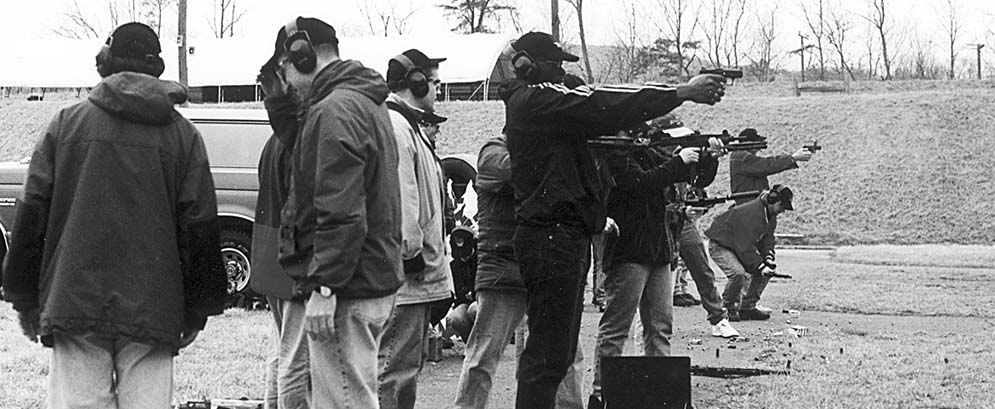A “grounded firing line” works best for large crowds when there are many assorted firearms with non-compatible ammunition. Each firearm is on the line with the ammunition directly behind it.
By Jim Schatz
“A successful demonstration is a day where no one at the demo gets hurt, all the guns work as designed, you hit all your targets and, if you are a salesman the customer leaves with the intention to buy your product, in that order. Strive for perfection!”
Safety is the first concern but preparation is the key to a successful demonstration!
(We now continue the helpful hints that the author started in SAR Volume 3 Number 12)
Specific Safety Guidelines and Precautions
1. Bring help if possible or “employ” (with or without compensation, maybe in exchange for a suitable company giveaway) persons associated with the range or the group that you are demonstrating to help with safety on the range. Strive to have one range safety person per every two attendees.
2. It is very effective and more manageable for large or inexperienced groups to have the attendees break down into two equal groups. Each attendee having an assigned “range buddy”.
One half of the buddy team shooting, the other half acting as a “coach” and watching for safety violations of his assigned partner, correct loading procedure, target results, etc. It gets everyone involved and participating and, most importantly, helps you run a safe and successful demo!
Don’t team spouses together. Very often they are too afraid or too eager to critique one another.
3. Run the range as a “grounded” range. Establish a firing line where the muzzles are all grounded along the firing line. Before, during and after the demo the weapons remain grounded in the “cleared” condition (on “safe”, magazines out/empty, slide/bolt locked rearward/breech open, chamber clear of brass or ammunition) except during the times that the weapon is being fired or you are using it for demonstration/briefing purposes. All firing is done with the muzzles of all the weapons along the firing line. No one moves forward of the firing line unless each weapon is “clear” and you or the Chief Range Officer allow it via command. In this way, the weapons are not moving in amongst the firers in undetermined conditions (loaded or unloaded). This also provides for any “clearing” mistakes that might be made by the firers.
Example 12:
During a live-fire demo to foreign military officers a manufacturer’s rep had just proficiently demonstrated an add-on 40mm LV grenade launcher to the attendees. A somewhat arrogant onlooker, in an attempt to hide his nervousness, stepped to the firing line to launch the first round, HE-FRAG provided by the host organization. The closest target was positioned 200 yards downrange. The rep watched as the firer loaded the grenade, aimed the weapon at the 200-meter target and commenced to demonstrate to the onlookers probably the world’s greatest flinch. The abrupt downward movement of the launcher coupled with the slow exit velocity of low velocity 40mm grenades drove the round into the dirt about 30 meters to their front. The effect of a dangerously close detonation was indeed dramatic. Somehow only one fatality resulted. At least one piece of the pre-fragmented shrapnel body within the grenade was propelled back at the firing line and right through the right ear cup of the rep’s hearing protection. No human was injured but the ear muffs were later buried with honors.
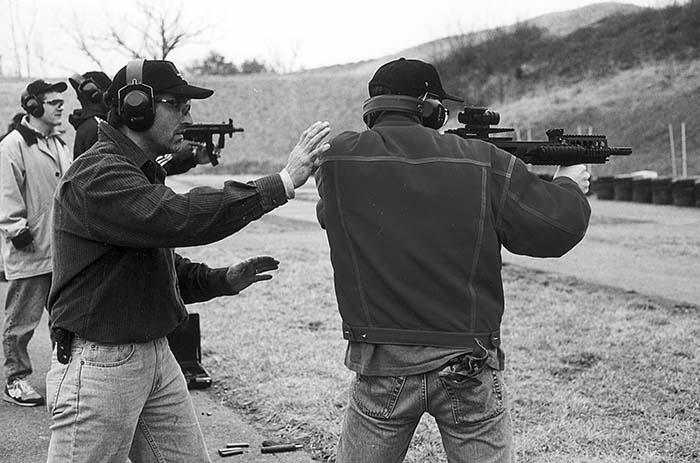
Lesson: There are three here. First. Expect the unexpected. Secondly. Utilize high explosive or fragmentation ammunition for attendee shooting only once they have demonstrated to you that they are safe enough to handle these types of rounds. Thirdly. Beware of the “know it all” attitude of some of those attending your demo. Small arms and their users represent a macho way of life for many. Look beyond their uniform or organization before placing a potentially dangerous weapon or type of ammunition in their hands in your presence.
4. Prior to the start of the attendee firing session, teach the shooters the correct loading and clearing procedures of the weapons on the firing line that you will allow them to fire. This will help increase the safe conduct of the demo and reduce the incidence of operator-induced stoppages and malfunctions that are easily blamed on the weapons. This “training”, along with suggested “correct” firing position for the weapon(s) being fired, is generally welcomed by most attendees and enhances their proficiency with the weapons, which helps sell the product in the end. This “training” can be done very quickly immediately after your Safety Briefing.
5. Take charge on the range! Be in control of the weapons you are responsible for and those persons who are shooting them. You should act as the Chief Range Officer while “your” weapons are being fired. Insure that all attendees know this and take all their commands from you and/or your appointed Range Safety Officers. It’s your demo. They’re your weapons. They’ll be your injuries if they happen.
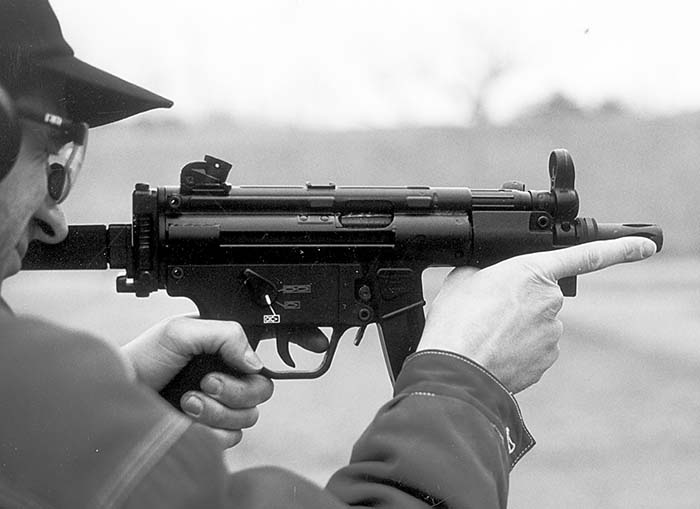
6. It is a good idea to “employ” additional personnel to help watch for the safe (and proficient) use of the weapons by the prospective customers during the demo. A ratio of one Range Safety Officer to every two shooters is preferred, but often not practical if you are alone for the demo. If additional Range Safety personnel are not available, reduce the number of firing points to what you are constantly able to monitor.
As an option, you can employ some of the attendees as “coaches”. Have the coaches standing behind the shooters watching that they properly load and unload the weapons and follow all of the safety procedures that you discussed during your Safety Briefing.
7. Conduct a brief to-the-point Safety Briefing for the attendees just prior to when the actual shooting begins. Concentrate on the key safety points such as:
a. Keep all weapons pointed up and down range at all times.
b. Keep fingers off of the trigger and outside of the trigger guard until you are aiming downrange and are ready to fire.
c. Follow the commands of the Chief Range Officer (you!) at all times.
d. Obey the “grounded” range procedures at all times. Clear all weapons and ground them along the firing line once you have finished firing. DO NOT remove the weapons from the firing line.
e. Wear eye and ear protection while shooting.
f. DO NOT handle or even touch weapons when someone is down range.
g. Anyone can call a “Cease Fire” if they see an unsafe act or for any reason.
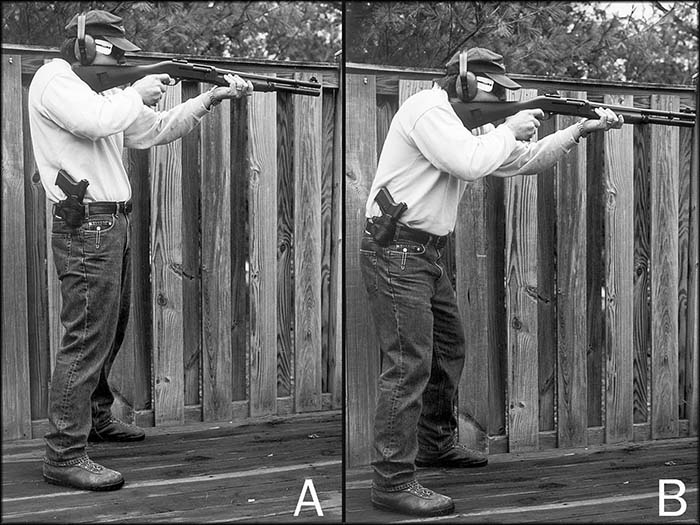
You can get a lot more detailed about safety rules but remember that your time is limited in a demo and most people will remember only a few key safety rules, so concentrate on a few key basic rules of safety, such as those listed above, that will prevent injuries.
After discussing the Safety Rules, explain the proper methods for loading, unloading, clearing and shooting the weapons.
8. Keep the fingers and hands away from the muzzles of short-barreled weapons at all times, especially while shooting weapons like the Mini or Micro UZI, HK MP5K, MP5K-PDW, the MP5K in the firing briefcase, Beretta M93, etc. and the short-barreled guns from an elbow supported position off of level support. (The non-firing hand tends to slide forward towards the muzzle when the shooter strives to “get low” on level surface such as the hood or roof of a car or off of a table.)
Example 13:
During a user conducted demo for the public a distracted range safety officer looked away from an inexperienced shooter with an HK MP5K with folding stock. A neighboring range safety officer looked over to see the shooter’s non-firing index finger placed precisely over the muzzle of the short 4.5-inch barrel. Before he could react the shooter pulled the trigger. Fortunately for everyone involved, the bolt was still locked rearward though a full magazine was inserted and the safety/selector lever placed on fire.
Lesson: NEVER take your eyes off of inexperienced or jittery shooters, especially when they are handling or shooting short-barreled weapons. They’ll do the darndest things!
9. Always demo short-barreled weapons (like Micro UZI’s or machine Pistols) or the HK MP5K-N or MP5K-PDW with a flash hider, barrel extension or sound suppressor attached to prevent fingers from wandering in front of the muzzle during firing. Always use the hand stop and/or flash hider on all short-barreled weapons whenever and wherever possible for demos.
10. Require wrap around eye protection for all persons on or near the firing line, especially when shooting on steel targets.
11. Have sufficient ear protection (plugs or muffs) available for those persons who arrive at the range without their own.
12. During range firing, stay alert for safety violations. Answer questions and tell stories after the firing line is closed and the weapons have been cleared. Keep your eye on the firers at all times!
Example 14:
During a major event on a military base in the U.S., demonstrations were conducted by various ammunition and small arms manufacturers. The demo was arranged and supervised by, well, let’s be kind and say people who should know better about the danger of firearms and ammunition. One overzealous manufacturer’s rep, supremely confident and obviously proud of the performance of his product, commenced to demonstrate to the crowd the minimal penetration characteristics of his training ammunition. At one point in his demo he placed a plywood target, through which his ammunition was not expected to penetrate, on a pole supporting the cover under which the, shall we say immediately suspicious observers were seated and staring at the back of the plywood target. The range safety officers stood quietly watching this event while the more experienced attendees fled the bleachers. Once it became apparent that the rep was actually going to fire a live training round into the board in the general direction of the crowd numerous people spoke up, most being other demonstrators in the crowd who had almost instantly moved to a position behind the rep. The range safety personnel remained quiet through it all.
Lesson: Know in advance what will transpire on the range and during the demo. Insure that the range safety personnel understand their function and that they are not afraid to sound off immediately in the event of a safety violation.
13. Separate non-compatible weapons and ammunition on the firing range. For example, separate the 9mm or .380 Auto weapons from those in caliber .40 S&W and 10mm Auto. Arrange these weapons on the firing line with some other guns separating them (i.e. shotguns, rifles, etc.). Place the .40 S&W and 10 mm ammunition directly next to or behind the applicable grounded weapon(s). Instruct the shooters not to load that weapon or its magazines with any ammo other than that which is positioned next to the weapon. Do not allow the weapons or their unique magazines to be intermixed on the firing line.
You must avoid getting a live 9mm or .380 Auto cartridge into a 10mm or .40 S&W magazine or weapon! The same applies to 10mm’s and .40 S&W’s in .45 ACP caliber weapons and 20 gauge shells in 12 gauge shotguns. These are just a few examples; there are many other non-compatible rounds. Should this occur, the entire live 9mm cartridge may slide down in and lodge in the 10mm/.40 caliber bore resulting in a dangerous obstruction. This obstruction will cause damage to the barrel and possibly injury to the shooter and/or bystanders should a 10mm Auto or .40 S&W cartridge be chambered and fired with the obstructed bore. This is extremely important between 9mm and .40 S&W pistols, as the magazines are often nearly identical or interchangeable.
14. Never purposely throw or drop guns for any reason, loaded or unloaded, during the course of a demonstration! This is very unprofessional and will get you thrown off the range in a heartbeat. It is also very dangerous!
15. Make certain that you keep the muzzle of the weapons pointed in safe direction, up and down range preferably, at all times during your demonstration and briefing. Always attempt to keep the weapon in a “cleared” condition during your briefing for additional safety purposes.
Example 15:
This is my favorite. Like Col. Jeff Cooper teaches, be aware of your surroundings at all times. During a public demonstration the hosts of the demo arranged to have a 25-yard range and 300 yard range available to the demonstrators. Hundreds of viewers overflowed from the small bleachers placed directly behind the firing line of the 25-yard range. The same bleachers were located immediately to the left and only slightly to the rear of the firing line for the 300-yard range, which ran at a 90 degree angle in a L shape to the 25 yard range. One contract demonstrator for a major manufacturer was demonstrating a newly developed fully automatic rifle-caliber shoulder weapon. Intently focused on engaging short range targets to his front on the 25 yard range he was unaware that some in the crowd had moved up along his side to get a closer look, to include various members of the gun press corps. And boy did they get a closer look! With the intention to impress the crowd with the ease that he could immediately transition to and engage long range targets on the 300-meter range the shooter smartly executed a 90-degree left pivot. This unexpected move had him firing downrange within meters of the stunned viewers who had moved in for a closer look (2500-fps razor close in fact). On certain select ranges at Fort Bragg or Dam Neck amongst real, highly trained and confident operators this move would not have been so unusual. In this situation it was downright dangerous.
Lesson: For demonstrations there should only be one firing line and one down range direction and everyone must know where these are. No cross firing should be permitted for any reason.
16. Always physically check that the chambers of the so-called “cleared” weapons are empty before going down range or before securing them after the close of your demo. DO NOT ASS-U-ME! If need be use a cleaning rod without a brush attached to “rod out” each weapon or repeatedly dry fire the cleared weapon downrange before removing them from the firing line.
Example 16:
After an otherwise successful demonstration, a manufacturer’s rep rushed to pack and load the cased .308 semi-auto sniper weapons into the company station wagon and started on the 2-hour drive home in heavy rush hour traffic. Upon returning to home station the weapons were unloaded, moved into the storage room and secured in the racks. The rifle that had been positioned directly behind and pointed at the unsuspecting driver was found to have a live .308 match round loaded in the chamber. The safety was not engaged, and of course the hammer was cocked. While this story ends happily it could have easily been an example of another person shot with an unloaded gun had the vehicle he was riding in been involved with even a minor fender bender!
Lesson: Visually and physically check each weapon before removing them from the firing line. Double check and/or rod each weapon to make sure they are clear.
16. Never handle, or allow any attendee to handle, any weapon when people are forward of the firing line, for any reason!
Example 17:
The photograph on the bottom of page 56 was not staged and says it all. An encroaching crowd anxious to get a good look at a seldom seen product, in this case the HK69 grenade launcher, surrounds a table where various weapons are laid out for display purposes. While the HK demonstrator is giving his briefing on the HK69 a member of the crowd decides he finds the suppressed MK23 pistol on the table in front of him even more interesting and totally irresistible. Without considering the man downrange our hero lifts the gun from the table, closes the slide on the pistol and begins sighting targets downrange. Fortunately, the gun was unloaded and never pointed directly at the demonstrator downrange. However, this information was not available at that moment to the unarmed demonstrator downrange.
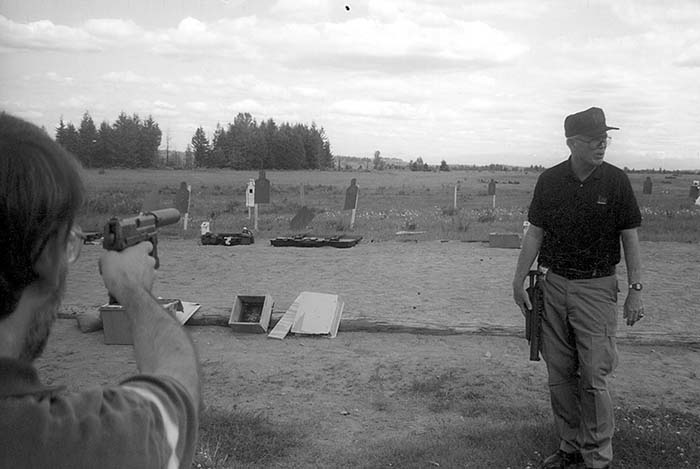
Lesson: Keep the weapons separate from the crowd and vice versa while you are conducting your briefing. Brief from along the firing line instead of in front of the firing line whenever possible. Have assistants on hand to insure no firearms are handled while anyone is in front of the firing line.
18. DO NOT allow anyone to fire a firing briefcase (MP5K, MAC-10/MAC-11, etc.) without one-on-one supervision!
a. Always mark the top and bottom sides of the briefcase with an arrow made of tape pointing in the direction of bullet travel.
b. Never allow someone to shoot the briefcase guns in a demo from any position other than the approved “High Chest” position (Hold the base {the opposite side from the firing port} of the briefcase held high against the chest, the sides of the case parallel with the ground, the carrying handle pointed to the right or left, and the firing port pointing down range!). Use an aggressive stable stance when firing the weapon in the briefcase. It can very easily knock you off balance due to its high rate of fire and relatively high center of gravity when fired from the high chest position.
c. The briefcase should never be fired while being held in the conventional carrying position of a briefcase (next to the leg with the arm extended) as the recoil of the weapon inside the case drives the case back behind the shooter’s leg(s). Ouch!
19. Always insure that persons that are shooting select-fire weapons and the semi-automatic shotguns assume an aggressive and stable firing position (boxers stance) to insure that they are not knocked off balance by the recoil of the weapon with a loaded weapon in their hands, finger on the trigger!
The squared-off firing stance similar to the isosceles pistol firing stance employed by some for smg’s provides insufficient support for heavy recoiling rifles, shotguns and large caliber submachine guns (.45 ACP and 10mm). While the proficient and well-trained shooter may be able to handle the hard kicking and high rate of fire weapons from the isosceles position, most attendees at demonstrations will not. The more conventional 45 degree stance with the feet spread slightly more than shoulder length apart and the rear foot providing additional support behind the lead foot will insure that the recoil will not push the shooter back onto his heels and ultimately totally off balance. This stance provides better stability and therefore generally better controllability (and thus more hits and less errant rounds) with rifle caliber weapons, shotguns and with weapons firing hot ammunition or with high cyclic rates of fire.
20. Keep live ammunition and/or loaded magazines or belts away from all weapons during the briefing portion of your demonstration. If necessary, use an empty magazine to demonstrate the safe loading and unloading procedures to the attendees.
21. DO NOT allow the consumption of alcoholic beverages or drugs before or during the demonstration. Secure the weapons and ammunition before allowing any consumption of alcoholic beverages. Send anyone away who appears to be under the influence of alcohol or drugs.
22. Have a first aid kit, water, transportation and mobile or land line telephone or radio communication (for emergency Medical Evacuation, if necessary) handy at all times while conducting a demonstration in the event emergency aid is required and not readily available using locally available assets. Many of the more rural ranges you may demo on have none of these items. Don’t be caught short when someone’s life may be at stake!
23. Be extremely careful with exploding targets!
a. Never place exploding targets closer than 25 meters to the firing line or bystanders, especially 3 and 5 inch targets.
b. Never place an exploding target in a position where upon detonation looses debris (gravel, rocks, cans, etc.) or target materials could be blown back towards the firing line or bystanders.
c. Never use exploding targets in an area where the ground cover is dry and flammable.
d. Always have a fire extinguisher readily available when using exploding targets (or tracer ammunition or other pyrotechnics). Never use pyrotechnics when the danger of fire starting as a result of their use is possible. When in doubt, err on the side of caution. Save them for another day.
e. Consider warning the attendees and asking the host of the demo if applicable if exploding targets (tracer and other pyrotechnics) can be used.
24. DO NOT allow attendees at demonstrations to wear hearing protection while you are giving them your verbal presentation, especially the Safety Briefing. They need to hear everything you say concerning range conduct and safety!
25. If you demo in the rain (and you will) do not place wet guns back into the cases. Once the foam is wet the moisture will remain and rust the guns over time (hours only). Dry, clean and lube the guns or hose them down with WD40 and wipe off the excess to displace the water if immediate cleaning is not possible. Detail clean the guns and dry the cases/foam ASAP! Remember – excess oil or WD40 sprayed on the guns will soak into the foam and get all over the guns (and you and the customers hands) each time the case is used. It can never be removed from the foam either and replacement foam can be expensive.
26. On very hot days, or where a lot of rounds are being fired quickly, have a tub or bottle of water on the range to cool down suppressors and forearms. A heat resistant “welders” glove or swath of heat-resistant material or kitchen potholder is always a handy item to have around, especially if you are demoing sound suppressors. Some customer will ultimately want to remove a scalding hot sound suppressor to shoot the gun unsuppressed or a machine gun barrel during or immediately after the shooting ceases but before the item has had a chance to cool.
27. Burying or dunking under water your prized Class III weapon before firing is not for the faint of heart but can make for a very compelling illustration, (if you have tried it previously and are confident in the product to attempt it) of the reliability of the weapon under harsh conditions. This is especially effective with hard core military customers who work in inhospitable environments. During these stages insure the muzzle stays clear of obstructions before firing and that no one moves in front of the buried weapon. A short strap attached to the weapon allows it to be easily located and retrieved without groping for it and unintentionally hitting the “naughty bits”(trigger, safety, muzzle, magazine release, etc.).
| This article first appeared in Small Arms Review V4N1 (October 2000) |



